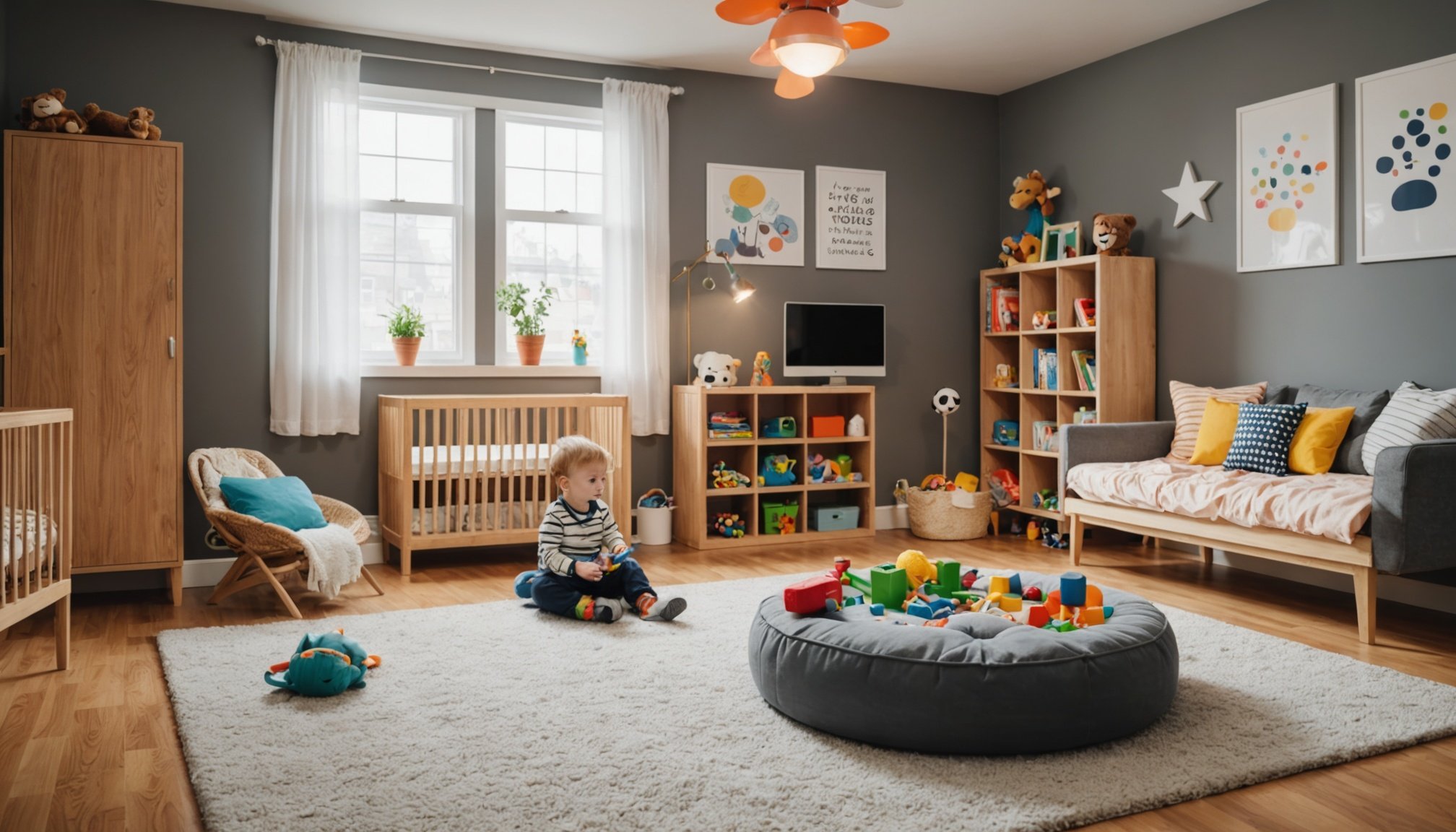Safety First: Ensuring a Secure Play Area
Creating a secure play area for toddlers is crucial to ensuring child safety in apartments. Childproofing your home should be a top priority to prevent accidents. One effective method is to install safety gates. These barriers help to restrict access to potentially dangerous areas, such as stairs or kitchens, reducing the risk of falls or injuries.
Using socket covers is another essential step, preventing toddlers from inserting objects into electrical outlets. These small, affordable devices can effectively eliminate the risk of electrical accidents, offering peace of mind to parents.
Also read : Crafting a Tranquil Zen Guest Room: Your Guide to Mindful Relaxation and Serenity
Furthermore, placing corner guards on furniture with sharp edges can avert unnecessary bumps and bruises. Relocate any hazardous materials, like cleaning supplies and medications, to high shelves or locked cabinets, keeping them out of inquisitive hands.
Maintaining a hazard-free play environment requires ongoing vigilance. Regularly check for small objects that could pose choking hazards and ensure that toys are age-appropriate and in good condition. Consistent supervision and maintaining clear sightlines in play areas guarantee quick responses to any potential dangers.
Also to read : Creative Ideas for Concealing a Play Zone in Your Family Living Room
By implementing these safety tips for toddlers, parents can create a sheltered space, allowing for both secure play and exploration.
Creative Space-Saving Solutions
Creating a functional and enjoyable living environment in a small apartment can be challenging. However, with space-saving design, you can turn these challenges into opportunities. Multifunctional furniture is key to maximising utility and making the most of your limited space. Think about items like a sofa bed or an ottoman with storage. These pieces provide practical solutions without compromising on style or comfort.
A genius trick for small apartment ideas is utilising vertical space. Shelving units that extend upwards can hold toys, books, or storage baskets, turning walls into functional storage areas. This approach clears floor space, making the living area less cluttered and more expansive.
In places where living space must be shared, creating defined play zones is important. Use rugs or curtains to delineate areas specifically for play, separating them from adult spaces. This not only helps in keeping toys organised but also encourages a sense of ownership and responsibility in children. Moreover, having designated areas makes cleaning and tidying up much easier.
These creative solutions will not only enhance the functionality of your home but also transform it into a harmonious space for everyone to enjoy.
Engaging Toys and Activities
Selecting age-appropriate toys is crucial for fostering a child’s growth. These toys should stimulate developing senses and skills. Opt for items like chunky puzzles, stacking blocks, and musical instruments that match toddler developmental stages. Such toys not only entertain but also enhance cognitive abilities and hand-eye coordination.
Incorporating toddler activities into daily routines can foster both enjoyment and learning. Simple arts and crafts, such as scribbling with crayons or creating shapes with playdough, develop creativity and dexterity. Storytime, using vibrant picture books, promotes language skills and imagination, while supervised water play is great for sensory exploration and introduces concepts like cause and effect.
Educational play is best complemented with outdoor activities, even within small apartment settings. Balcony gardens can be a source of exploration and responsibility by allowing children to learn about plants and growth. Repurpose areas for mini obstacle courses or use chalk for games like hopscotch. These activities encourage physical development, spatial awareness, and social skills when done with siblings or neighbours.
Bear in mind, the balance between structure and freedom in activities can significantly impact a child’s enthusiasm and readiness to learn. Explore various options to find what resonates best with your toddler’s unique interests and energy.
Organization and Storage Strategies
Effective storage solutions are essential to maintain an accessible and tidy play area. Incorporating baskets and bins can greatly simplify toy organization. They offer an easy cleanup method that encourages children to put away toys after playtime. Consider using clear or labelled bins so children can quickly identify where toys belong.
Decluttering tips involve routinely evaluating the toys you currently have and consciously deciding which are in regular use. Rotating toys is an excellent technique to maintain engagement and prevents kids from becoming overwhelmed by multiple options. Store a portion of the toys away and cycle them every few weeks. This not only keeps the play environment fresh and exciting but also teaches children to appreciate their possessions without the chaos of having everything available at once.
Strategically design storage areas to be at a child’s height, engaging them in the cleanup process independently. Shoe organisers with pockets can also be repurposed for easy access to small toys. Utilise vertical space in closets by adding extra shelving or hanging baskets. By implementing these strategies, you foster an organised, clutter-free environment conducive to both play and learning.
Budget-Friendly Tips for Parents
Finding ways to entertain your child without breaking the bank can be challenging. However, discovering affordable play solutions doesn’t mean compromising on quality. One effective strategy is to opt for budget-friendly toys, such as those made from durable materials or that have multiple uses. They can stimulate creativity and endure longer play sessions.
Exploring DIY projects is another great way to create engaging play equipment at home. With basic materials, you can craft a variety of cost-effective designs. For instance, repurposing household items into imaginative props or simple building kits can provide hours of fun.
When considering thrift shopping, look for opportunities to purchase second-hand items. Many good-quality toys are often found at a fraction of their cost. Inspect items thoroughly for safety and cleanliness, ensuring they are suitable for your child’s age and interests. Opting for generic brands can also help stretch your budget further without losing out on fun.
By combining smart purchasing choices and creativity, you can create abundant and enriching play environments for your children without spending a fortune.
Real-Life Examples and Case Studies
The challenge of designing a toddler play space in a small apartment can seem daunting, but many parents have successfully navigated this terrain. Consider the case of Jane, a mother of two living in a compact urban flat. She transformed a corner of her living room into a vibrant play area by using multi-functional furniture and vibrant wall decals to create a welcoming and stimulating environment.
Parenting testimonials often highlight the significance of creativity over space. One mother, Sarah, shared her strategy of using under-bed storage for toys, making cleanup easy and efficient. Such innovations are key insights into designing effective small-apartment play spaces.
Moreover, case studies offer practical ideas. In one study, a family used collapsible play tents that could be easily stored when not in use, maximising space utility. This design choice, praised in their parenting testimonials, underscores the importance of flexibility in play space arrangements.
Caregivers often testify to the benefits of zoning the play area, allowing toddlers to enjoy various activities in a limited space without feeling restricted. These real-life examples prove that, with thoughtful strategies, even the smallest areas can accommodate a vibrant and functional toddler play space.











